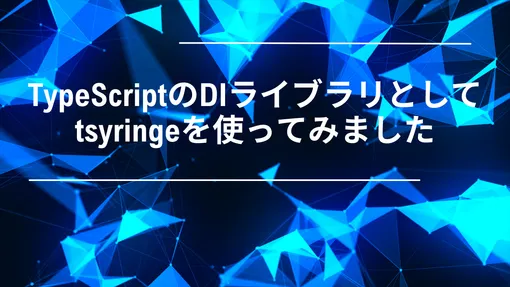
TypeScriptのDIライブラリとしてtsyringeを使ってみました
はじめに
現在、色々な個人開発を行っています。その中のひとつにSwitchbotとNature Remoを連携させたワークロードがあります(この話はまたどこかで)。 この連携ワークロードの開発はTypeScriptを利用しているのですが、ここでDIライブラリとしてMicrosoftが提供しているtsyringeを使っています。 今回は基本的な利用方法を記載していきたいと思います。
サンプルユースケース
基本的な利用方法は、上で軽くお伝えした連携ワークロードに出てくる簡単なユースケースをもとに記載できればと思います。
Switchbotのデバイスを表すDeviceエンティティを用意しています。
このデバイスの状態に応じて、Nature Remoを動作させるためのメッセージを送信するので、notifyというメソッドが備わっています。
デバイス
このエンティティを表すクラスが以下のコードです。
このクラスメソッドのnotifyはデータベースへデータ登録も行います。
そのため、このクラス自体にはデータベースを操作するためのオブジェクトをメンバーとして保持しますが、ここに依存性の注入(Dependency Injection / DI)があります。
これを実施するためのライブラリとしてはtsyringeを使用します。
import { autoInjectable, inject } from 'tsyringe'
import { IDeviceDatabase } from './deviceDatabaseInterface'
import { FinishState } from '../../type/switchbot/finishState'
@autoInjectable()
export default class Device {
readonly id: string
readonly status: string
readonly battery: number
private readonly database?: IDeviceDatabase
constructor(
id: string,
status: string,
battery: number,
@inject('IDeviceDatabase') database?: IDeviceDatabase,
) {
this.id = id
this.status = status
this.battery = battery
this.database = database
}
public notify = async (): Promise<FinishState> => {
// databaseに対してデータを投入する部分のみ抜粋
await this.database.register()
}
}依存性を注入するクラスに対しては、@autoInjectableアノテーションを記述します。
一方、依存先に対しては、@injectアノテーションを利用します。
@inject('IDeviceDatabase')のように引数にはトークンと呼ばれる、依存性を示す識別子を指定します。
データベースとインターフェース
依存先であるIdeviceDatabaseインターフェースとその実装であるDeviceDynamoDBは以下のようなコードになります。
今回のデータベースはDynamoDBを利用しているので、実装としてはDynamoDBテーブルへのPutItemを記述しています。
import Device from './device'
export interface IDeviceDatabase {
register: (device: Device, messageId: string) => Promise<void>
}export default class DeviceDynamoDB implements IDeviceDatabase {
private readonly client: DynamoDBDocumentClient
constructor() {
this.client = DynamoDBDocumentClient.from(new DynamoDBClient({}))
}
public register = async (device: Device, messageId: string): Promise<void> => {
const command = new PutCommand(
{
TableName: `<dynamodb_table_name>`,
Item: {
Id: device.id,
Status: device.status,
Battery: device.battery,
MessageId: messageId
}
})
await this.client.send(command)
}
}インスタンス生成
デバイスのインスタンス生成に際しては、まずIDeviceDatabaseとしてDeviceDynamoDBの依存性を注入するためにcontainer.register()を利用します。
これの第一引数には、先程の@injectアノテーションで指定したトークンと同じ値を記述します。
import { container } from 'tsyringe'
import DeviceDynamoDB from './repogitory/dynamodb/device'
import Device from './entity/switchbot/device'
const main = async () => {
container.register('IDeviceDatabase', {
useClass: DeviceDynamoDB
})
const device = new Device('sampleDeviceId', 'sampleDeviceStatus', 100)
await device.notify()
}
main()さいごに
いかがでしたでしょうか。tsyringeを利用することで比較的簡単にDIを実現することができました。 今回は備忘のための記事なので、サンプルコードを主体にしてブログを記載しましたが、誰かの役に立てれば幸いです。